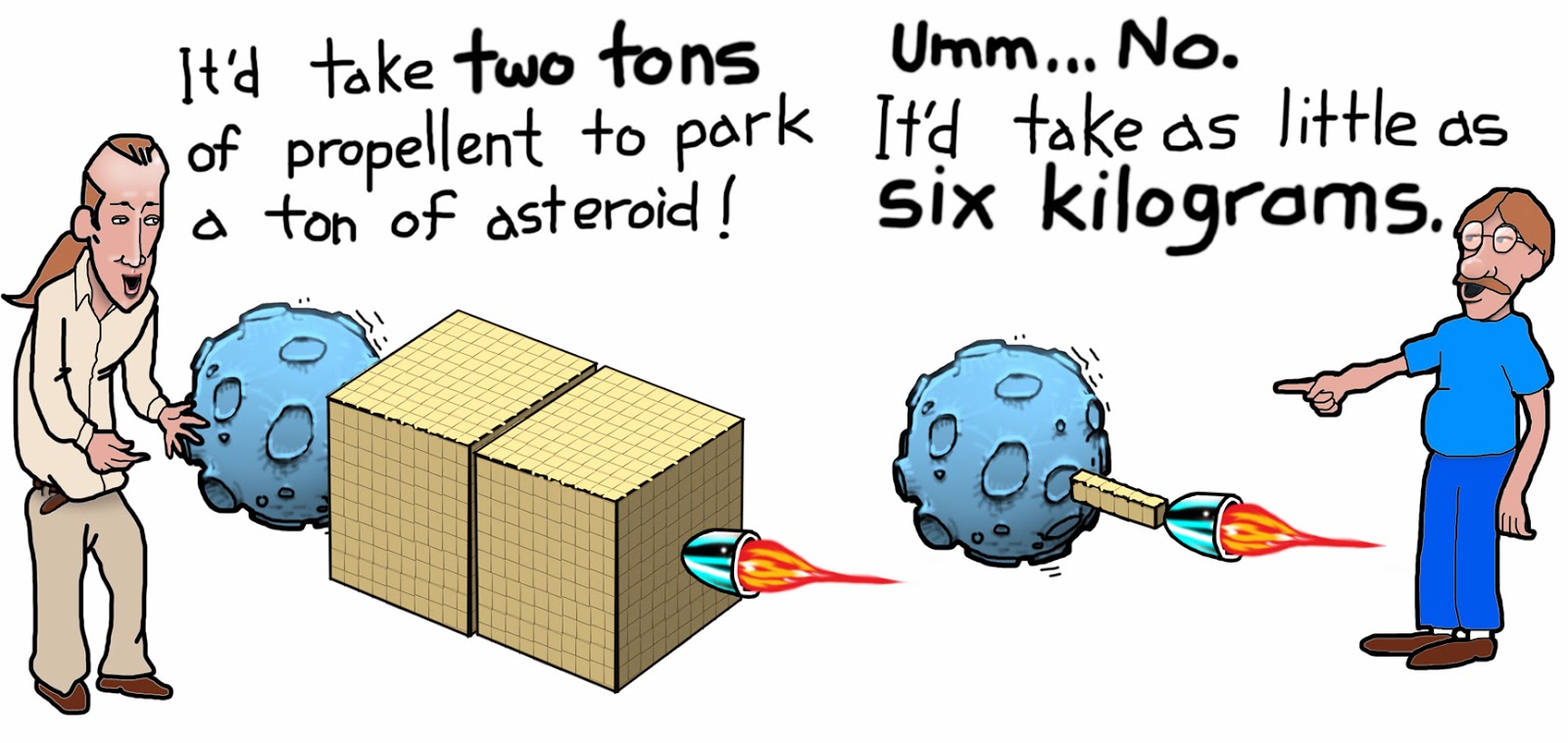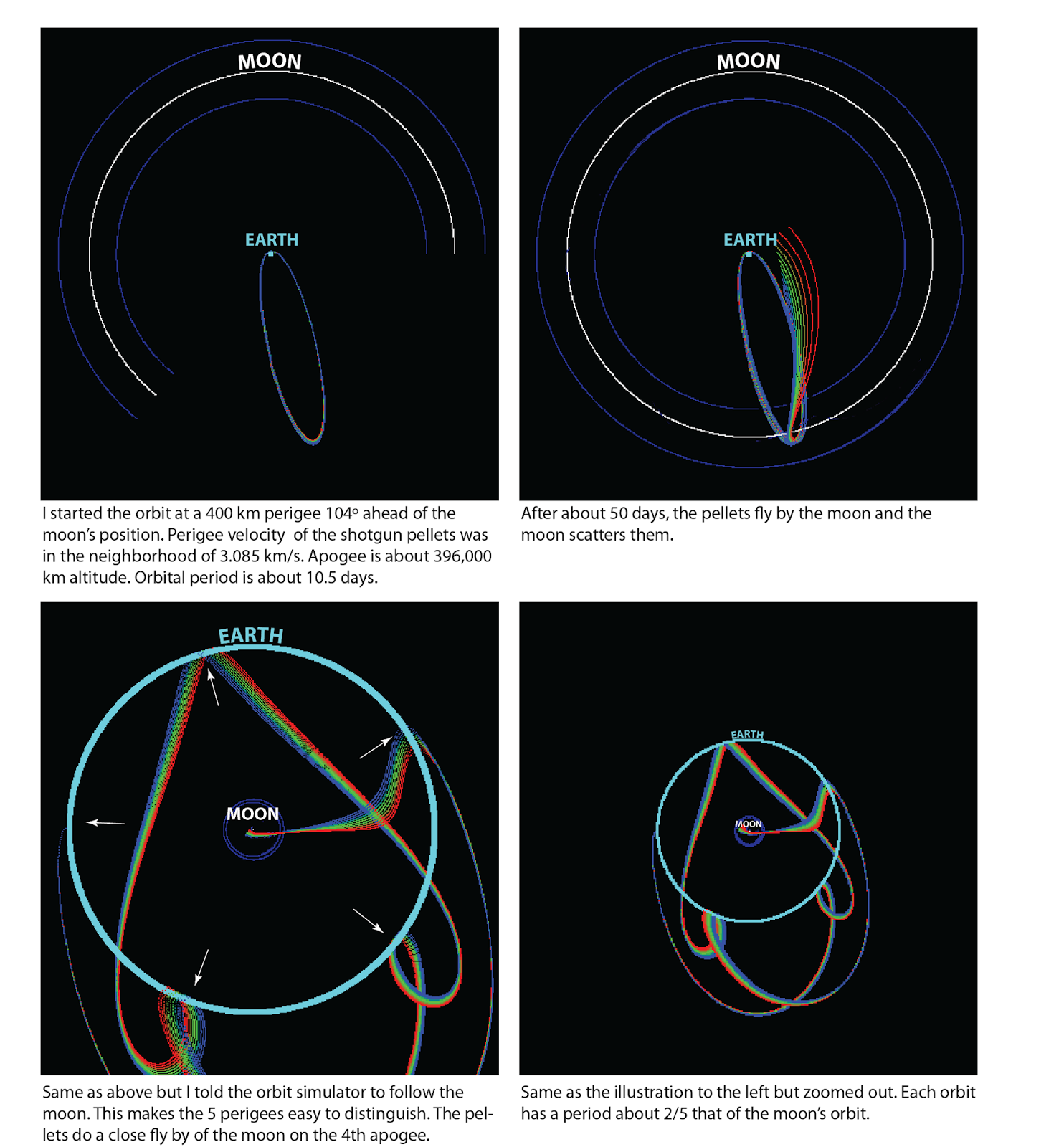Earth Moon Lagrange 2 or EML2 is one of 5 locations where earth's gravity, moon's gravity and so called centrifugal force all cancel out. It lies beyond the far side of the moon at about 7/6 of a lunar distance from earth.
Infrastructure at any of these 5 locations could be kept in place with a small station keeping expense. Other high earth orbits would be destabilized by the influences of the earth, moon or sun.
Of these 5 locations, EML2 is the closest to escape. How close?
Specific orbital energy is given by
v
2/2 - GM/r
v: velocity with regards to the earth
G: gravitational constant
M: mass earth
r: distance from earth center
Here's specific orbital energies for a few orbits:
For EML1 and EML2 I'm looking at resulting earth orbits for payloads nudged away from Luna's
Hill Sphere.
Most the energy is getting from earth's surface to Low Earth Orbit (LEO). Then another huge chunk is getting from LEO to escape.
EML2 is right next door to escape (aka C3=0). If the goal line is Trans Mars Injection, EML2 is on the 9 yard line.
EML2's orbital energy is about -180,000 joules per kilogram. How much is that? Well, Kattie is standing next to the small generator which provides electricity for our business during power outages during the summer monsoons. It would take this 20 kilo-watt generator
9 seconds to crank out 180,000 joules.
An EML2 payload nudged away from Luna would rise to an 1.8 million km apogee. An ordinary earth orbit at 450,000 kilometers from earth's center would move about .94 km/s. But since EML2 is moving at the moon's angular velocity, it is traveling 1.19 km/s. Earth's Hill Sphere is about 1.5 million km in radius. So depending on timing, an EML2 nudge could send a payload out of earth's sphere of influence into a heliocentric orbit.
Another possibility is the sun's influence could send a payload back towards the earth with a lower perigee:
All of these pellets were nudged from EML2. The sun's influence has wrested most of these from earth's influence. But check out pellet number 3 (orange). The sun's influence has dropped this pellet to a perigee deep in earth's gravity well. For a .1 km/s nudge from EML2 we can get a deep perigee that can give a very healthy Oberth benefit. However, such a route takes about 100 days.
Using an lunar gravity assist along with an Oberth enhanced burn deep in the moon's gravity well, EML2 is 9 days and 3.5 km/s from Low Earth Orbit (LEO):
This route was found by
Robert Farquhar.
Bi-Elliptic TransfersIt radii of two different orbits differ by a factor of 11.94 or more, a
bi-elliptic transfer takes less delta V than Hohmann. EML2 radius / LEO radius is about 67, so LEO to EML2 could definitely be a beneficiary of bi-elliptic.
From LEO, a 3.1 km/s burn gets us to a hair under a escape. A multitude of elliptical orbits fall under this umbrella!
As you can see, it takes almost as much to get as high as EML1 as it does to reach a 1.8 million km apogee. I chose 1.8 million as an apogee since a 450,000 x 1,800,000 km ellipse at perigee has the same altitude and speed as EML2. At perigee a payload can slide right into EML2 with little or no parking burn.
What's needed is an apogee burn to raise perigee to 450,000 km. A 6738x1,800,000 km ellipses moves very slow at apogee, a mere .04 km/s. A 450,000 x 1,800,000 km ellipse doesn't move much faster at apogee, about .3 km/s So a .26 km/s apogee burn suffices to raise perigee.
So the total budget is .26 + 3.1555 km/s. This 3.42 km/s delta V budget is better than a Hohmann but about the same as Farquhar's 9 day route.
But recall apogee is beyond earth's Hill Sphere. With good timing,
the sun can provide the apogee delta v.
Here's a route I found with my shotgun orbital sim:
LEO burn is about 3.11 km/s. Payload passes near the moon on the way out, boosting apogee and rotating line of apsides. The sun boosts apogee as well as perigee. Coming back the pellets slide right into EML2 (the circular path alongside the Moon's orbit).
This LEO to EML2 route took 74 days and 3.11 km/s.
EML2 and Reusable Earth Departure Stages.
Using the Farquhar route, it takes about .4 km/s to drop from EML2 to a perigee moving just under escape velocity. At this perigee .5 km/s will give Trans Mars Insertion (TMI). After the departure stage separates from the payload it's pushing, it can do a .5 km/s braking burn to drop to an ellipse with a near moon apogee. Once at the moon, another .4 km/s takes the EDS back to EML2.
For massive craft moving from between earth's neighborhood and other heliocentric orbits, it makes little sense to climb down to Low Earth Orbit (LEO) and back each trip. It saves time and and delta V to park at EML2 on arrival. If EML2 becomes a stop for interplanetary space craft, a reusable EDS is a good way to depart the earth/moon neighborhood.
EML2 and Fast Transits
Here's a pic of a Non Hohmann Mars transfer:
Mars and earth orbits are approximated as circular orbits. A Hohmann orbit will have a 1 A.U. perihelion and a 1.52 A.U. aphelion. The transfer orbit above has perihelion .7 A.U. and aphelion 1.53 A.U. Semi-major axis of this orbit is (.7 + 1.53)/2 A.U. or 1.115 A.U. Orbital period is 1.115
3/2 years which is about 1.18 years.
The trip to Mars isn't the entire orbital period though, just the turquoise area swept out from departure to destination. The turquoise area is 31.5% of the ellipse's area. 31.5% of 1.18 years is about 135 days or about 4.4 months.
Departure and arrival Vinf are indicated by the red arrows. These are the vector differences between the transfer orbit's velocity vector and the planet's velocity vector at flyby. A change in direction accounts for most of the Vinf. I'm assuming Mars and Earth are in circular orbits with a zero
flight path angle. Therefore the direction difference between vectors can be described with the flight path angle of the transfer orbit's velocity vector.
In this case the earth departure Vinf is 11.3 km/s. That's a big Vinf! But if falling from EML2, only a 4.9 km/s perigee burn is needed. This is doable.
At Mars the Vinf is 5.14 km/s. But a periaerion burn of 2.57 km/s brakes the orbit into an (3697x2345 km ellipse. This orbit could be circularized via periaerion drag passes through the upper atmosphere. Since this ellipse has a period less than a day, orbit could be circularized in a few weeks.
An upper stage can have a 8 km/s delta V budget. Recall it takes about .4 km/s to fall from EML2. Therefore let's try to find a route that takes about 7.6 km/s from perigee burn to periaerion burn.
Trial and error with my
Non Hohmann Transfers spreadsheet gives:
With chemical rockets departing from EML2, I believe 4 month trips to Mars are doable.
EML2 Proximity to Possible Propellent Sources.
In terms of delta V, time and distance EML2 is quite close to several possible propellent sources.
There are thought to be frozen volatiles in the lunar cold traps. Some craters at the lunar poles have floors in permanent shadow. Temperatures can go as low as 30 K. Volatiles that find their way to the cold traps would freeze out and remain. There may be rich deposits of H
20, CO
2, CH
4, NH
3 and other compounds of hydrogen, carbon, oxygen and nitrogen. These would be valuable for life support as well as propellent.
The moon's surface is about 2.5 km/s from EML2.
Also there are proposals to retrieve asteroids and park them in lunar Deep Retrograde Orbits (DROs). DROs are stable lunar orbits that can remain for centuries without station keeping. Planetary Resources would like to retrieve water rich carbonaceous asteroids. Carbonaceous asteroids can contain up to 20% water by mass in the form of hydrated clays. They can also contain compounds of carbon and oxygen.
LDROs would be about .4 km/s from EML2.
SummaryEML2 would make a great transportation hub. Not only for travel to destinations throughout the solar system but also within our own earth moon neighborhood.


































































